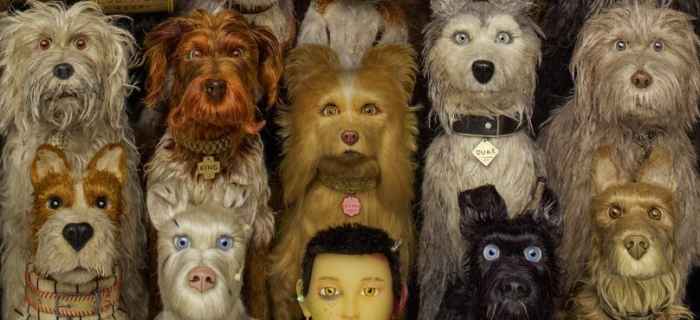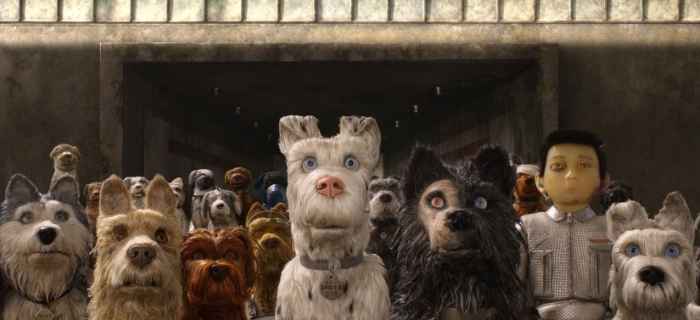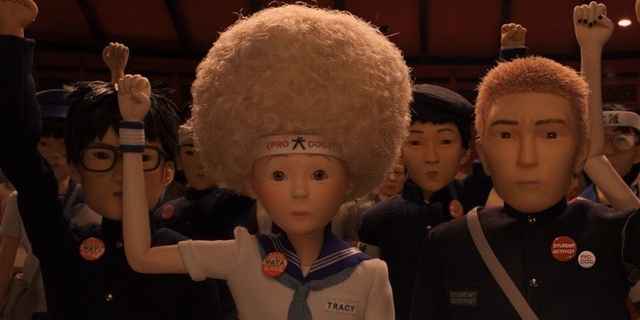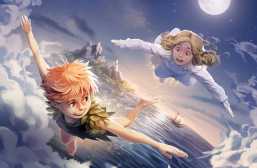Isle of Dogs: Humanity in the Inhuman

In his most recent film, Isle of Dogs, Wes Anderson manages to portray a thoughtful investigation of humanity within a story dominated by canine characters. The 2018 stop-motion movie explores ideas of oppression and political corruption in a world where “man’s best friend” has become ostracised. A dark reflection of our society is presented under a guise of childlike absurdity, the film’s cast composed of about 900 puppets. While it focuses on the unfortunate experiences of its doggy protagonists (voiced by Bill Murray, Edward Norton, Jeff Goldblum, Bob Balaban and Bryan Cranston), at its core, Isle of Dogs is about humanity. Exploiting the emotions of its dog-loving audience, the film’s storyline evokes empathy, encouraging us to remember that we all desire safety, comfort and companionship. In doing so, Anderson’s film responds to the philosophical problem of “othering” the animal, particularly reflecting the work of the French philosopher, Jacques Derrida. Further addressing the question “who are we?”, the film manifests humanity in its medium, neglecting celebrity culture in favour of hand stitched costumes and painted freckles. In both its dystopian storyline and intricate visual elements, Isle of Dogs reflects the importance of positive, unified communities in our society.
A Reflection of Human Politics

Isle of Dogs provides parallels of our current political climate. In the film, the mayor of the fictional Japanese city, Megasaki, spreads anti-dog propaganda, inciting fear and hatred among his citizens. Mayor Kobayashi and his colleagues claim that the once popular pets are now a public health issue, afflicted with dog flu and snout fever which will inevitably infect the human population. Although Kobayashi’s rival, Watanabe of the Science Party, is developing a cure for the illnesses, this fear leads to the banishment of dogs from their metropolitan home city to the desolate Trash Island. This dystopian tale parallels instances of real groups being alienated from society. The exile of these dogs mirrors a trend of isolating groups of people on islands in order to remove them from the rest of society, such as in the case of refugees being imprisoned in offshore detention camps on Nauru and Manus islands by the Australian government. Trump’s obsession with deportation also comes to mind.
While references to specific instances of real oppression are not overt, it is clear that Isle of Dogs intends to cultivate empathy for a group of outcasts, whose well-being is threatened by a prejudiced political agenda. The film focuses on humanising these victims and therefore reminding audiences of the impacts of discriminatory polices. Of course, these victims are dog puppets – yet with their barks supposedly translated into English, they are anthropomorphised (allotted human qualities) so that audiences learn about each of their individual interests, families and favourite foods. Anderson has said: “Our dogs are people. They are voiced by people, they think like people, but they go through the experiences of dogs.” By combining canine appearances with human attributes, Anderson predisposes viewers to be empathetic. While giving these creatures the power of language, Anderson capitalises on a common love for dogs and a tendency to want to take care of them.
A Philosophical Discussion

In its exploration of the human condition, Isle of Dogs appears to address the philosophical problem of “othering” the animal. This concept has been thoroughly investigated by French philosopher, Jacques Derrida. The Animal That Therefore I Am, an English transcript of Derrida’s 1997 lecture on his book The Autobiographical Animal, questions why we distinguish animals from humans. In doing so, he demands a logical justification for the violent treatment of animals: experimentation, consumption, etc. He states that “No one can deny seriously any more, or for very long, that men do all they can in order to dissimulate this cruelty [towards animals]”, contending that humans’ treatment of animals must improve. Derrida extends the idea of genocide, usually reserved for human suffering, to inhuman animals, claiming that they face “genocidal torture” for the sake of “alleged human needs”. By applying the term “genocidal” to the slaughter of animals and thus suggesting they are victims, Derrida evokes empathy for animals. Derrida also suggests that referring to animals as “animals” is reductive of a broad variety of species, and each of these species’ individual characteristics. Wes Anderson seems to take this a step further by individualising all of his dogs, implying that they can vary in the same way that humans can: they can have preferences, interests, sensitivities. Perhaps they can also spread rumours or understand the TV.
Like Derrida, Anderson identifies alienation as the cause of violence towards animals: the Kobayashi government exiled the dogs because they saw them as fundamentally different (and inferior) to humans. Clearly, Isle of Dogs is fantastical. Regardless, through anthropomorphism, it makes the radical suggestion that humans should see dogs as equal beings. It rejects the idea that logical reasoning could ever override the important role of empathy in human society. The film seems to suggest that this empathy itself is integral to the human condition.
A Sense of Creative Community
The use of stop-motion animation in Isle of Dogs also works to explore humanity, emphasising the importance of community and human touch. In each still of the film, objects are meticulously crafted – such as the expressive creases of the characters’ plastic faces and the minuscule sixties inspired interiors. In the above “making of” video, the head of the puppet painting department, Angela Kiely, describes the process of painting 297 freckles on each face of the character Tracy Walker (an ambitious exchange student and adamant pro-dog advocate). As the camera pans stadiums of nameless characters, each of their outfits are individualised and hand-sewn. No matter where the audience looks, they cannot avoid the fact that all visual elements of the film have been carefully stitched together by a team of creatives. Anderson makes the comparison: “when you get a group together of people who have really honed these skills for making miniatures, for making tiny props and creating these puppets, it’s like you were given the 500-piece absolute A-level orchestra.”
Underlying the engaging visuals and plot of Isle of Dogs is a definite sense of community, something not always visible in the seamlessness of live action films. In addition to the importance of the puppets and miniature props themselves is the way in which they have been animated: by the movements of a person’s hand. The figures are guided organically by a person rather than by technology, unlike with other forms of modern animation. This increases the sense of humanity behind each character, regardless of their material composition.
A Focus on the Fundamental
Ironically, the absence of real actors also furthers these human elements, distancing the film from celebrity culture and instead establishing a focus on the characters’ fundamental qualities. While we can hear famous voices (such as those of Bill Murray, Jeff Goldblum and Scarlett Johansson) we don’t physically see these actors at all, we only observe their characters. Western society’s obsession with Hollywood actors means that the inclusion of their faces and bodies in films is a typical selling point. Anderson subverts this. The visual absence of real actors in Isle of Dogs means that the characters are less constrained, as their appearances, expressions and movements can be engineered entirely in accordance with their personalities. This gives the creators an opportunity to further explore fundamental human concepts, rather than external human appearances.

Another effect of the film’s lack of human actors is an implication of equality between the subjects and the viewer. Isle of Dogs subverts the usual divide between the unrelatable movie star on screen and the everyday audience member. This extends the exploration of shared humanity throughout the story, the common qualities between dogs and humans, students and politicians, children and adults, etc. In the same way, equality and humanity are addressed with careful composition and cinematography. This is demonstrated in the way the dogs are portrayed at eye level, in the same manner as the human characters. Rarely does the camera look down at the dogs, and when they meet “the little pilot”, Atari, he appears to have a similar stature to them. This signifies that he is a part of their pack, transcending the usual owner/pet hierarchy.

While some might assume it to be immature due to the presence of talking dogs, Anderson’s film thoughtfully considers what it means to be human. It acknowledges the harm and destruction caused by society, while raising spirits with signature playfulness. Ultimately, the product of the film itself is a joyous reminder of what humans can accomplish when they work together for a positive cause.
What do you think? Leave a comment.











this is so insightful and interesting! you illuminated some really clever points that i hadn’t thought about before. this is an amazing bit of writing.
Thanks so much!
This review highlights numerous clever points that never even crossed my mind but I totally agree with them. Really does the movie justice. Best piece of writing I’ve come across in a while, it kept my interests, that’s for sure.
Thank you!
Brilliant article, isle of dogs I one of my favorite movies!
Great article.I never managed to watch the movie, but now I think should!
Great article. I like how there’s a lot of creepy political imagery in this film that people don’t see to see while they’re fixated on the cute doggos.
The weakest part of this for me was the formulaic Good Versus Evil story line which really lacked originality.
I really enjoyed this movie and the artistry of Wes Anderson was fully on display, but despite the arresting visuals there was a great story and wonderful humour. Maybe it could have been twenty minutes shorter, my only gripe.
I’ve had my fingers burned by overindulgent anthropomorphic schmaltz down the years and also found Anderson’s ‘Fantastic Mr Fox’ far too clever for it’s own good as it forgot to tell a story.
This film. Wow. Simply wow. The whole package – animation, sound, art direction and, most of all, a cracking story – have made this my favourite movie. It had more in common with ‘Song of the Sea’ and ‘Spirited Away’ than ‘Mr Fox’ and was so much the better for it. And it’s funny too.
I did think Fantastic Mr. Fox was amazing visually and that the script was clever, but Isle of Dogs has so much more heart, in my opinion. The story is just so unique, fresh, and relevant.
While I loved Isle of Dogs, and wholeheartedly agree that it’s a beautiful and unique film, I simply can’t condone the whiff of negativity around Fantastic Mr Fox. Which is, well, fantastic.
One of my all-time favourite films, I love it more and more with each watch, and as it’s hard not to compare it to Isle of Dogs, I’d have to go with Fox over the hounds as my favourite.
FMF is my favourite film of all time. I liked Isle of Dogs but the setting of the story was far too long, and it didn’t explore the dog gangs characters at all. Which was a shame.
If I have one criticism of Dogs, it’s that the lead characters are all a little too samey with none of them really coming through to shine, while Clooney’s Mr Foxis such a strong lead presence.
Enjoyed reading this analysis a lot. I think what really makes it work given the gulf between the ridiculousness of the premise and the investment you need to have in what’s happening on-screen is its very specific tone of gentle humour, which makes it a wonderful, whimsical experience.
Thanks so much for reading! The humour in this film was really fantastic, I would consider it the funniest Wes film to date.
This animation was so good that we watched it twice in the cinema. It was my daughters 16th and she is a huge Wes Anderson fan.
I ended up seeing it three times in the cinema! And all the people I saw it with loved it!
This article has very much sold me on seeing this movie. When I first saw the trailer a couple months ago, I thought it was creepy looking (the dogs aren’t as cute as you want dogs to be, idk, I guess that was really it) AND! I was put off that there were Japanese characters and a predominately all white cast. When I saw the trailer a second time, I paid closer attention to the plot line and I was begrudgingly intrigued, but still annoyed about the white-washing thing. But, now I see that it’s less about representing Japanese culture exclusively and more about representing humanity. Awesome. Can’t wait to watch it.
I’m so glad this has convinced you to give the movie a go! I also wasn’t sure about how to feel about the depiction of Japanese culture from the trailer. I was glad to see, though, that the story was co-written by Kunichi Nomura. Also, I think its great that Japanese language was incorporated so much into the film!
What I think is such a cool element about the animation is that it’s not over the top Pixar cute. It makes the message of humanity all the more present because the film isn’t selling cute puppies in shenanigans. The animation gives the dogs the dignity of humanity. So that’s rad.
It is good to see the development of interesting interpretations of the use of animation, and especially in the form of this type of hand-craft work that has such a unique feel to the visual result. Thanks for sharing a great and timely discussion.
Thanks! And thank you for contributing to the editing process of this!
Class film. So many great voices used very well.
A visual feast and worth seeing!
I thought it was wonderful when I was watching it – full of invention and wit. Strangely, that feeling hasn’t really stayed with me, although I still think it was very good, probably one of his best.
Lovely analysis. I thought it was a wonderful film.
A beautiful film, which has made me keen to explore some of the film-makers that inspired Anderson for it.
Kurosawa.
I feel that the rating of PG, betrays the film which is more suited to mature audiences who can understand the little details that make the film.
I was really looking forward to this but was a bit underwhelmed. Worth seeing but I preferred Mr fox.
It was a weird film and I think I enjoyed it. My 15 year old did, but my 11 year old said it was boring and he didn’t understand much of it.
One howl of a movie.
The English/Japanese thing is such an excellent and novel touch.
Saw this film and enjoyed it immensely.
I love Dogs. Heh. Enjoyed it but a bit of editing around the two thirds in mark wouldn’t have gone amiss.
This is one of the most interesting articles I’ve read. I have not watched the film, but will do so now. This topic and film also touches upon the importance of empathy and selfless actions, which much of mainstream media has, in a way, helped many people consider these types of acts as “corny” or “too nice”. Many people today do not openly talk about being empathetic, and the like. If society stops categorizing “empathy” and “being nice” as something icky and to be aware of, people may definitely be less critical of each other.
cool movie
This film is definitely at or near the top of my list so far this year. The artwork, cinematography, and attention to detail are incredible.
Wow. Awesome article. I really love reading articles about dogs.
Great article and points, it was a very positive take away. I respect the message Isle of Dogs presents and am glad you’ve shared it with others.
I agree that the ‘playfulness’ of the film is important. While we can and should compare the setting of the film to current political climates, the film ultimately occupies a space beyond those parallels. It exists as a work of art in its own right. I was so interested to read the philosophical background to this film.
Everything in this movie is so gosh darn symmetrical. It is beautiful to look at. The sushi making scene is so much fun to watch. I swear I could give this movie a 10 on aesthetic alone.
I appreciate that the film made the decision to have the human characters speak Japanese (since the story is set in Japan). While there are some sequences where we get no translation of what the Japanese characters say, there is a great balance and variety between how their lines are translated.
The history of Japanese conquest of Korea and China seems to hover in the background of Isle of Dogs.